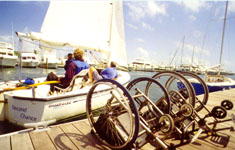Top
Ten Tips for Mobility Impaired Travelers Planning a Trip

1.
MAKE A LIST of questions and potential barriers in step-by-step sequence
for each place or activity you are exploring. Have you previous experience with
someone with a mobility impairment? Was that person able to walk some distance
or confined to a wheelchair? Can staff assist me? Are there any steps to negotiate?
Are areas paved, gravel or sand?
2.
CALL FIRST and speak to the owner, manager or someone in authority
for answers to your questions. If you prefer or need to remain in a wheelchair,
know your dimensions (from your toe to the outside of your back wheel; widthwise,
from wheel to wheel; and your overall weight) so you can explain your needs. Write
notes, including the name of your contact! 3.
CALL AGAIN! The
day you'll be checking into a specific accessible accommodation, call that morning
to confirm. After making reservations through a central office to rent a specific
model car, call the manager at the location to confirm the details the week that
you'll be picking up the car. 4.
BRING DUCT TAPE to repair mobility equipment,
wrap your hands for long distance wheeling if you don't use gloves and myriad
other uses. 5.
REQUEST BULKHEAD SEATING on the airplane so you have more room to transfer
onto the seat and are close to the front. Even if you can't get pre-assigned bulkhead
seating, the gate crew will usually be able to accommodate you. 6.
BUCKLE UP in your own portable seat belt when boating or doing other
potentially turbulent activities. Buy a portable seat belt and two ratchet tie-downs
with hooks at both ends. (These are usually available at an automotive store.)
You can run the seat belt across your shoulder and around the back of the chair
to hold you in your wheelchair or boat seat. Run the tie-downs through your back
wheels and secure the hooks to something solid to keep your wheelchair stationary. 7.
USE A BIKE RACK on your car to hold your wheelchair or other equipment.
This will leave more trunk room and bike racks - like baby strollers - can be
easily checked on airline flights. 8.
LOOK FOR FLOATING DOCKS when boarding boats. Even where the body of
water is not tidal, water levels can fluctuate during droughts or rains and floating
docks that rise or lower with the water level can make boarding a boat easier. 9.
ASK TOURIST CENTERS for any available
access information. Several centers have developed lists of lodging and tourist
activities that are readily accessible. 10.
WATCH ANY NEW ACTIVITY before deciding if you can tackle it. Talk with
the operator to see what concerns they might have. Observe step-by-step how somebody
else boards the helicopter, roller coaster or glider; how do they ride; how do
they land. Decide for yourself if and how you can do it safely and comfortably.
Wheelchairs
on the Go:
Accessible Fun in Florida is available:
online
at www.wheelchairsonthego.com;
and by phone 727-573-0434 or 888-245-7300. |
|